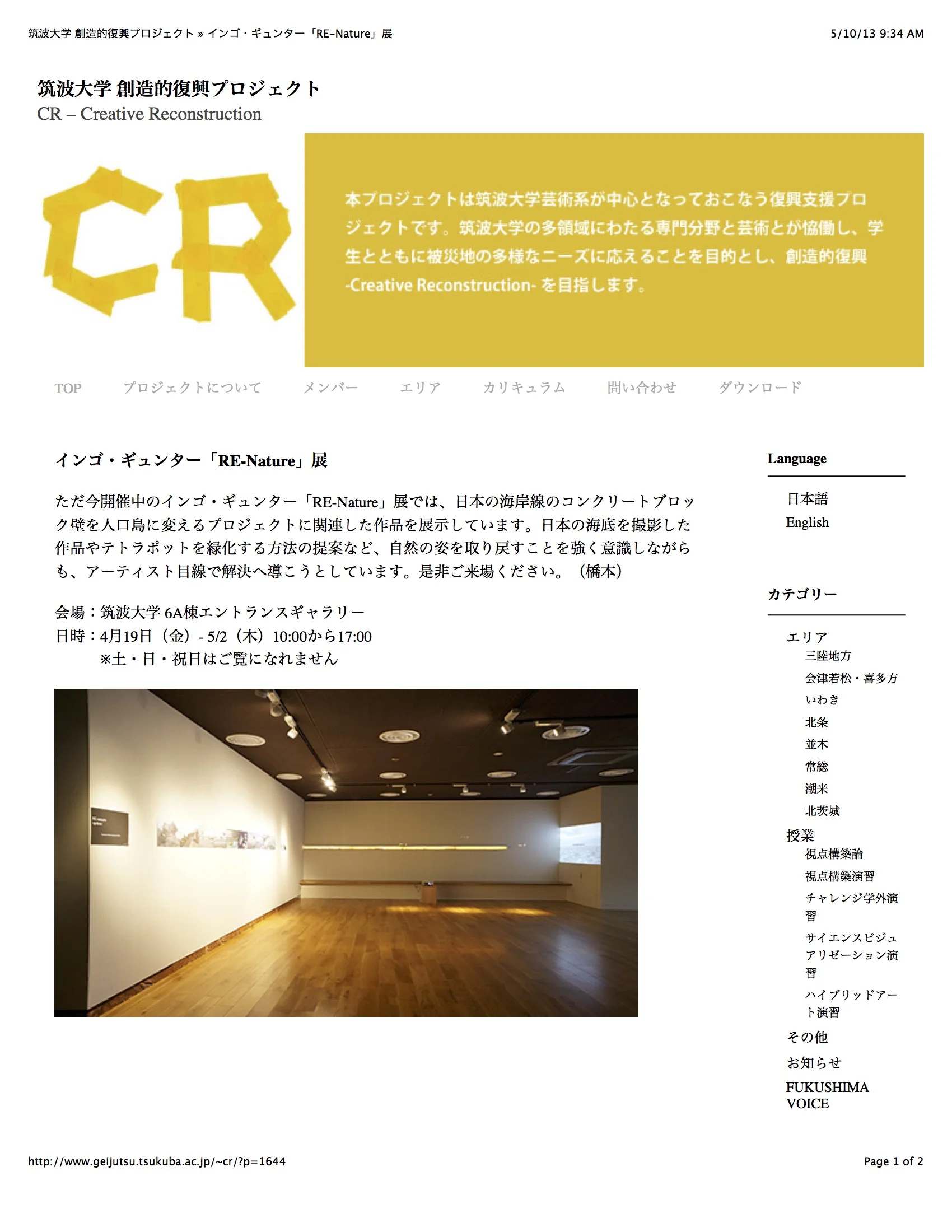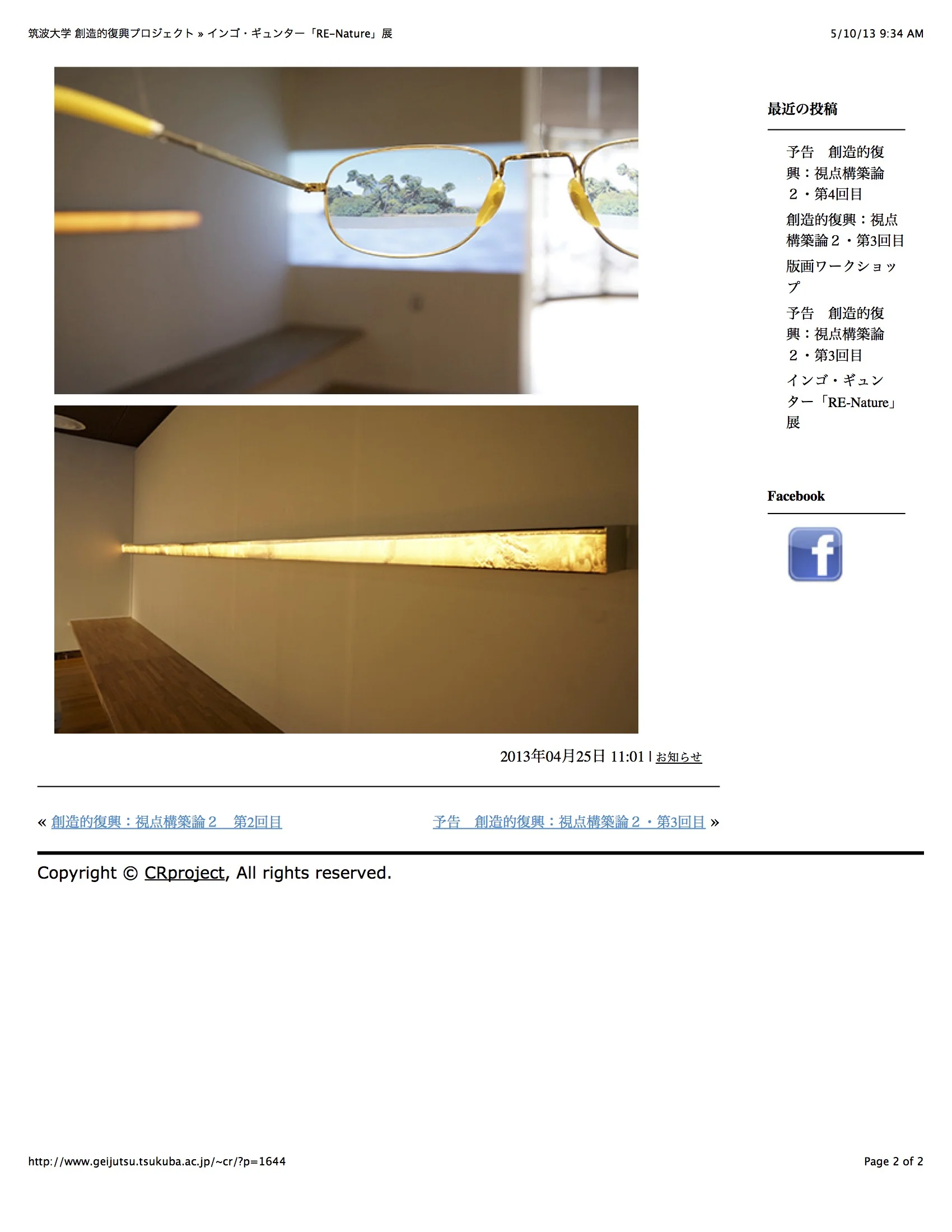海岸線の
コンクリートブロック壁を
人工島に変える
RE-NAture
Transformation of Coastal Concrete
Barrier Installations into Artificial Islands
日本版海岸線慕情
東長寺アートプロジェクツのための提案
2009年8月 インゴギュンター
By 1993 55% of the Japanese coastline was barricaded with artificial concrete boulders or encased in concrete in order to preserve the shape of Japan.
There is a discrepancy between the desire and intent of the Japanese to support a sustainable and ecologically responsible environment and their opportunities to do so. (this issue is not confined to Japanese. Generally people would rather do good things if they would know how and where and when). Japan used more than 80 million tons of cement in 1991. In 2000 Japan produced about twice as much cement as the global average, and between 1920 and 2000 Japan was the world's third-largest producer of cement per capita, surpassed only by Switzerland and Italy.
TECHNOLOGIES
Japanese construction companies have unique experience with submarine and marine architecture and construction. A similar if different capacity is found among Dutch and French companies. There is also great expertise in Israel with saltwater irrigation and salt water plants as part of the greening of the Negev desert.
The goal is to identifyanddevelop viable, community based strategies for the re-naturalization of Japanese coastal erosion barrier systems in order to integrate them both functionally, culturally and ecologically -- and to improve them.
CONSENSUS
Everybody agrees that the ubiquitous concrete pods that litter the Japanese coast, especially the beaches are an eyesore, that they not only protect beaches but also ruin the beaches and our communication with nature. They limit the vision of the ocean, one of the most fundamental and substantial sources and representation of life, beauty, eternity, serenity... nature itself. They cause an aesthetic problem with nature perception and they present ultimately a perceptual and psychological barrier between our deep-seated need to connect with nature. They are a constant reminder of man's interference with nature and man's inability to live in harmony and in tune with nature.
Most everybody agrees that they fulfill a vital purpose of protecting the scarce Japanese homeland from erosion and literally being washed into the sea one wave at a time. Some people argue that not only are they ugly, they ultimately may not help to prevent nature from taking its course and actually having a negative impact on the ecological balance of the maritime ecosystem.
“Whether in pursuit of a "Beautiful Country" policy, or for ecosystem sustainability, Japan is sorely in need of a comprehensive coastal preservation and conservation policy.”
(Japan Times July 2007)
What is an Island?
Islands are disconnected. The are separated from land and from each other. Floating in the infinity of the Ocean.
Every one is a small universe onto itself. Like Japan, Hawaii, Galapagos. The varying degree of isolation has determined and shaped their uniqueness. Each one of them has a particular flavor.
Too a degree, the smaller the island the more delicate its ecosystem.
Under the United Nations Convention on the Law of the Sea, an island is "a naturally formed area of land, surrounded by water, which is above water at high tide. Rocks which cannot sustain human habitation or economic life of their own shall have no exclusive economic zone.
BUILDING ISLANDS
People have tried to build and shore up islands throughout history. It is nothing new. Except today we have the technology (and need) to build them faster and more durable than ever before.
To mention a few types and notable examples: Oil Platforms, Fixed ocean buoys, Airports (e.g. Kansai International), Qatar's Gulf archipelagos, Mitsubishi's mining island near Nagasaki.
Small volcanic islands rising from the continental shelf have been shored up and fortified in order to remain constantly above water - in order to lay claim to an extended exclusive economic zone around that island.
AESTHETIC PRODUCTS
As much as a tangible result is intended, there should be an aesthetic result as well.
The aesthetics component is not only a goal in itself. The aesthetics are also needed to help convey the project to an audience, to engage their imagination and help guide their motivation. But whatever visuals will be produced, they will also be regarded as a stand-alone result of the project that should be regarded as initially sufficient.
PERSONAL MOTIVATION
My work always wants to have a strong link to reality and at best even a positive influence on and interaction with real world issues. In this case my personal obsession and experience with water and the Ocean contributes.
Japan has long been enamored of fortifying and excluding. Just as Japanese rulers toiled for centuries to build impermeable castles and maintain uncrossable borders, so too in the modern age the nation has sought to harden its coasts against waves and currents, loath to give an inch to the sea. (S.Hesse)
Fudo Tetra Corporation, has a line of 18 different blocks that range in size from half a ton (90-cm high and 1 meter in width) to 80 tons (5 meters high and 6 meters wide). TETRAPOD is a registered trademark held by Fudo Tetra, but it is also a generic term used, written in lower-case letters, to refer to any of the concrete blocks that come in a variety of configurations, with three to eight legs.
"Today's earthworks use concrete in myriad inventive forms: slabs, steps, bars, bricks, tubes, spikes, blocks, square and cross-shaped buttresses, protruding nipples, lattices, hexagons, serpentine walls topped by iron fences, and wire nets. "These projects are mostly unnecessary or worse than unnecessary. It turns out that wave action on tetrapods wears the sand away faster and causes greater erosion than would be the case if the beaches had been left alone,"
(A Kerr)
Tetrapod may be an unfamiliar word to readers who have not visited Japan and seen them lined up by the hundreds along bays and beaches. They look like oversized jacks with four concrete legs, some weighing as much as 50 tons. Tetrapods, which are supposed to retard beach erosion, are big business. So profitable are they to bureaucrats that three different ministries — of Transport, of Agriculture, Forestry and Fisheries, and of Construction — annually spend 500 billion yen each, sprinkling tetrapods along the coast, like three giants throwing jacks, with the shore as their playing board.
1993年までに、日本の海岸線の55パーセントは保護を目的としてコンクリート塊でバリケードされた。日本人が持つ、持続可能でエコロジカルな環境を保護したいという意図と現状との間には、かなりの食い違いがある(この問題は日本人に限ったことではない。一般的に言って人間はその方法、場所、時期がわかれば、なるべく良いことをしたいと思うものだ。)
1991年、日本は8,000トン以上のセメントを使用した。2000年の日本のセメント生産量は世界平均の2倍になっている。1920年から2000年までの間は、スイス、イタリアに次いで日本が世界第三位のセメント生産国だった。
テクノロジー
日本の建設会社は、海中/海洋の土木工事について、特有の経験を持っている。程度の差こそあるものの、同じようなことはオランダの会社にも見られる。イスラエルはネゲブ砂漠緑地化事業の一環として、海水による灌漑、海水性植物についての専門知識を有している。本プロジェクトの目標は、実行可能な、コミュニティをベースにしたやり方で、日本の海岸線の侵食を防ぐバリアシステムを再度自然化することにある。それは機能的でなくてはならないし、文化的にもエコロジカルな面でも違和感のないものに改良されるべきである。
コンセンサス
そこかしこに偏在するコンクリートのテトラポッドは日本の沿岸の景観を損ねている、と誰もが思っている。特にビーチの状況は見るに耐えない。海岸を保護するという名目のもとに、海岸線の景観および人間と自然との対話を台無しにしてしまっている。生命、美、永遠、静寂、自然そのものの根源であり象徴でもある海の最も美しい姿を損い、私たちの自然に対する憧憬の前に立ちはだかる視覚的、心理的バリアとなっている。テトラポッドのある風景は、常に私たちに、人間の自然への介入と、人間が自然と調和して生きられないことを思いださせる。
殆どの人は、テトラポッドが浸食と文字通りひと波ごとに洗い流される日本の領土を守る、という重要な役割を果たしていることを認めている。しかし一方では、醜いのみならず、自然が辿るべき流れを歪め、事実、海のエコシステムの生態バランスに悪影響を及ぼすもの、ともいわれている。
「『美しい国』のための政策を追求するにしろ、エコシステムの持続可能性を重視するにしても、日本には包括的な海岸線の保護政策が必要である」
(ジャパンタイムズ 2007年7月)島とは何か?島は他から離れている。島は本土からも他の島からも隔離されている。永遠に海に浮かび続けている。島はそれぞれが小宇宙を成す。日本、ハワイ、ガラパゴス。孤立の程度によりそれらの特異性が決定づけられ、形成される。それぞれの島は固有の風土をもつ。ある程度言えることとして、島は小さければ小さいほど、そのエコシステムが繊細なものになる。
国際連合海洋法条約によれば島とは;「水に囲まれていて自然に形成された、満潮時にも水面下に沈まない土地。人間の居住不可能な土地、あるいは経済活動ができない岩の周囲は排他的経済水域とはいえない」
島を造る
歴史を通じて、人は島を作ろうと試みてきた。それは何も新しいことではない。しかし、現代において人類はこれまにないほどの速さで地盤を造成し、補強する技術(と必要性)を有している。
いくつかの類型と顕著な例としては、海上石油プラント、固定型海上ブイ、空港(関西国際空港)、カタールの湾岸群島、長崎近くの三菱の炭鉱島があげられる。
大陸棚から隆起した小さな火山島は、排他的経済水域を確保するために島の周囲を棚上げされ、常に海の上に浮かんでいるように補強されている。
浮かぶ島、ドイツ、ヴォルフスブルク
沖ノ鳥島、日本、東京
美的な産物
形あるものとしての結果が求められるとともに、そこにはアートとしての審美的な結果もあるべきであろう。美的要素は目標としてのみならず、計画を人々に伝えるために必要なものであり、人々の想像力や動機を導くのに役立つ。しかしながら見た目がどうであれ、このプロジェクトの独立した結果として当初の目標を達成したものでなくてはならない。
個人的動機
私の作品は常に現実との強い繋がりをもち、現実世界に対する肯定的な影響、現実世界との相互関係をもってきた。この計画においては、水と海に対する個人的な強い興味と経験が役立っている。
日本は長い間、土壌の補強と他者の締め出しに夢中になってきた。歴代の支配者たちが何世紀にも渡って侵入不可能な城をつくり、侵入できない国境線を維持することに懸命だったのと同じように、近代においても、日本国家は波や潮に対抗して海岸線の強化に余念がなく、ほんの少しでも海にさらわれてたまるものか、と努めてきたのである。(S・ヘッセ/Japan Times)
不動テトラ株式会社は0.5トン(高さ90cm、幅1メートル)から80トン(高さ5メートル、幅6メートル)のものまで、18種類ものコンクリート・ブロックの製品ラインをもつ。「テトラポッド」は不動テトラの登録商標だが、通常は3から8個の脚をもつ、様々な形状のコンクリート・ブロックの総称としても使われている。
テトラポッドという言葉は日本を訪れたことがなく、海岸や港湾に何百という数で並べられたテトラポッドを見たことのない人にとっては耳慣れない言葉かもしれない。見た目は、4本のコンクリートの突起をもつ巨大な構造物で、ゲームに使うジャックのような形をしている。大きなものは重量50トンにもなる。
テトラポッドは海岸線の浸食を遅らせるためのものであり、大規模事業である。それがもたらす収益もまた莫大で、国土交通省、農林水産省、環境省は、それぞれ5000億円もの予算をテトラポッドに割いている。あたかも3人の巨人がジャックをばらまくがごとく、テトラポッドを海岸線にばらまいているかのようだ。
「現在の土木工事は無数の形状のコンクリートを使う。厚板、階段、棒、レンガの形状のもの、チューブ状のもの、スパイク状のもの、ブロック、四角ばったまた十字形のバトレス、突起したニップル、格子、六角形、鉄のフェンスやワイヤーのネットに覆われた蛇行した壁」
「これらのプロジェクトは不必要であるか、不必要どころか弊害をもたらすものだ。テトラポッドにあたる波はテトラポッドがない時よりも砂を速く運んでしまうし、何も置いていない海岸線よりも浸食が進むのが早い」
(A・カー/Japan Times)
コースタル・アムール・プロジェクト
東長寺アートプロジェクツ(仮)
ドラフト0.6 2009年8月25日
企画書はこのページを含めて11頁(英語原文)
日本語訳11頁
©2009 インゴ・ギュンター
プロジェクトのウェブアドレス
RENATURE.ORG
Tsukuba University, 2013

